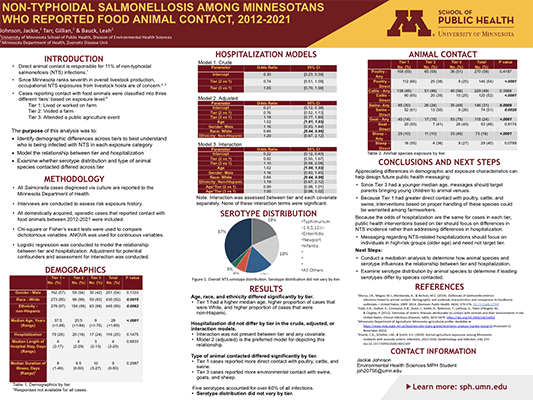Jackie Johnson
MPH, Environmental Health
Advisor:
Dr. Gillian Tarr
Keywords:
Salmonella; livestock
Abstract
Although foodborne transmission is considered responsible for the majority of non-typhoidal
salmonellosis (NTS) cases, 11% of all cases are thought to be acquired through direct animal
contact. Recent work has demonstrated that those with higher levels of animal exposure, such
as farmworkers, face a disproportionate risk of infection. In this analysis, NTS cases that
reported animal contact during exposure interviews were categorized into three tiers based on
their exposure level, with tier 1 representing the greatest degree of animal exposure.
Demographic and exposure variables were compared across tiers to describe the risk profiles of
cases belonging to each tier. Chi-square and Fisher’s exact tests were conducted to determine
whether these risk profiles differed significantly by tier. Age, race, and ethnicity were found to
differ by tier. Furthermore, the type of animal species with which cases reported contact also
varied across exposure level. Although NTS serotype did not differ by tier, some serotypes were
found to be associated with the contact of certain animal species. Appreciating these
differences in demographic and exposure characteristics may be useful in designing future public health messaging to reduce the incidence of animal-associated NTS infections. As animal-
associated NTS outbreaks continue to rise, particularly among backyard poultry operations, tailored messages that resonate with the varied needs of each tier are critical to ensure that all
at-risk populations are being informed.

View Poster (PDF)
